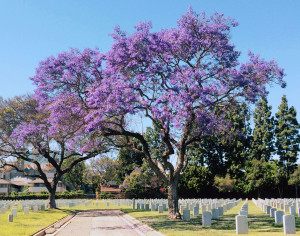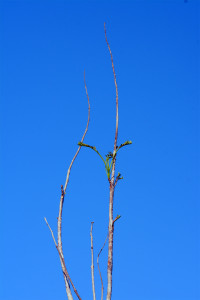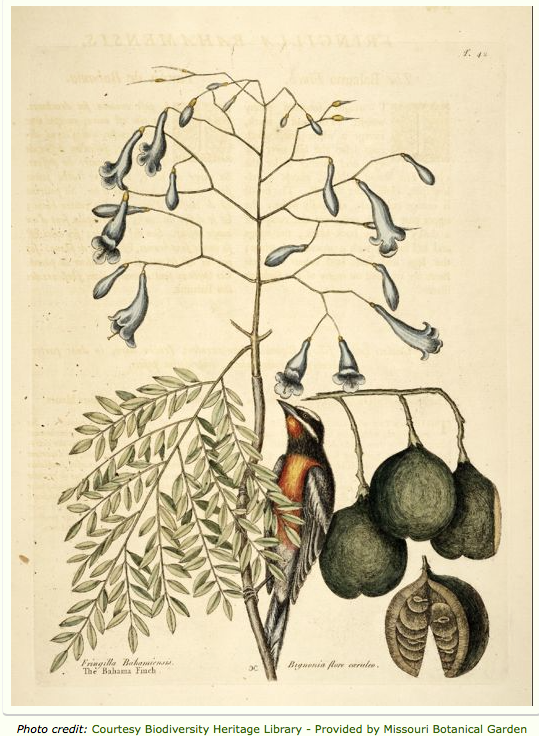One of my favorite memories of my decade spent at UCLA was seeing the huge trees with all the purple flowers and the flowery name: Jacaranda. They were scattered all over campus, in front of the library, in the courtyard outside a classroom I was in a lot, in the sculpture garden, near the top of the Janss steps, etc. They were all, I’m fairly sure, the predominant species available in the nursery trade (Jacaranda mimosifolia, also known as J. acutifolia), which comes from South America and is perfectly suited to the climate in southern California: dry summers and cool, wet (well, wettish) winters. It flowers for a couple of weeks a year and the trees are truly something to behold during that time. Here is a lovely one from the VA cemetery in Westwood:

There’s a beautiful one in the front yard of my father’s house in Southern California as well, but I don’t have a picture of it—yet.
Here in south Florida, though, the climate’s too hot and wet in the summer for those trees to really thrive. Don’t get me wrong—they’re available, and when properly cared for they can look pretty good, but they wouldn’t be right for my yard. Their crown is very broad, and I don’t have a lot of horizontal space in my yard, particularly in the narrow planting area I have reserved for it. The spread of those Brazilian Jacarandas can be quite impressive (as much as or more than a good Royal Poinciana, which I finally had to have taken down a year or so ago after it had been the crowning glory of the neighborhood for decades).
So my landscape lady and my native-plant-nursery man both recommended Jacaranda caerulea, a nice slender tree that grows well here in the Caribbean (Bahama, Cuba, Dominican Republic). In fact, its common name, at least around here, is Bahama Jacaranda. It has a longer flowering season than the more commonly available species, and, if not native it’s at least naturalized in south Florida. Furthermore, when in bloom, it’s apparently a very attractive nectar plant for several species of butterfly in the islands; presumably there will be some customers among the Floridian lepidoptera as well.
Sold!
For a tree that’s going to serve as a focal point, I knew that I’d have to begin by preparing the ground. So I started a couple of days before I traveled up to the nursery to get the tree. I had a bunch of old roots from that poinciana to remove, which meant a good couple of sessions with a mattock and shovel. As anyone who’s dug them up knows, roots of old trees might not be much to look at, but they sure can be difficult to dig.
So on April Fools’ Day this year, soil all prepared, I went up to Mesozoic Landscapes nursery in Lake Worth to get another semi-exotic flowering tree to replace the previous exotic flowering tree. At the nursery, I was a bit surprised by what Richard brought out for me: a ten-foot-tall twig that barely fit in my van with all the rear seats stowed or removed and the front passenger seat reclined to maximum. There were three or four tiny little leaves poking out at the top:

The tree looked so barren that the rock and mulch man at the Bushel Stop (I had stopped off on my way home to pick up yet another ten bags of pea rock and ten bags of mulch; feels like that’s all I do these days is buy pea rock and Florimulch….) asked me whether the tree was OK (“no leaves”); I assured him, more confidently than I felt, that it was just fine.
When I got home, I dug a bit deeper with the shovel to make sure I had removed all the old tree’s roots that were likely to cause conflict with the new one. As I dug, I found almost pure sand underneath a thin layer of topsoil. I amended the sand with a bit of the pea rock and some fertilizer that I had handy. Then I plopped the root ball down in the hole, added some more pea rock, sand, and fertilizer, gave it a final top dressing of pea rock, watered it in, and now I’m sitting back awaiting the results.
Should be good times ahead.
With the tree safely in the ground, I decided to do a bit more research. Interestingly enough, although this tree is not the most commonly encountered Jacaranda today, it serves as the type species of the genus. Mark Catesby, whose name has only recently returned to prominence among the early explorers of North America, illustrated this tree from the Bahamas back in the 18th century, along with a beautiful island bird that sometimes shows up here in south Florida: the stripe-headed tanager—er, Western Spindalis.
Here’s the link to the page on Plantilus; I also include a screenshot in case the link expires as they are wont to do:
In my copy of Catesby’s Birds of Colonial America (lamentably illustrated only in black and white, apart from 20 selected plates at the front), editor (and birds-as-dinosaurs denier) Alan Feduccia1 explains that the bird is depicted in the “boxwood or cancer tree (Jacaranda caerulea).”
Waitaminnit—the what tree?
That’s right. The cancer tree.
Having never been to the islands, I had never known what the islanders called these trees. But that tidbit in Catesby prompted me to look more deeply into the ethnobotany. And according to the website for the Leon Levy Native Plant Preserve on Eleuthera island in the Bahamas, these flowering jacarandas are indeed known as Cancer Tree and Boxwood. Other names for the tree include What-o’clock, Clock Bush, Knucker Box, and Horse Bush.
And as it turns out, at least according to Duke’s Handbook of Medicinal Plants of Latin America, in the Bahamas people apply a “parched leaf decoction to skin cancer and other skin ailments,” while in Cuba, they use a “leafy branch decoction to bathe eczema and pimples.” Presumably they also used the wood of the tree to make boxes.
Once I found the common names listed on the Leon Levy website, I decided to take a look at the botanical description of the tree while I was there. And oh, my, that description is a treasure trove of botanical terms; I’ve added notes to try to unpack them, but I’ll probably have to write separate articles on each term before I truly come to, um, terms, with them:
The zygomorphic2 flowers are arranged in panicles3. The calyx4 has 5 unfused sepals5. The corolla6 has 5 fused purple, pubescent petals with 2 upper lobes and 3 lower lobes. There are 5 stamens7 and the upper center stamen is highly pubescent8. The ovary9 is superior10 with 2 locules11 and numerous seeds12. The fruit is a flat brown capsule at maturity that splits apart to disperse the seeds. The seeds are winged.
Interestingly enough, the botanists at Leon Levy consider that this tree is not a true Bahama native. Apparently, like Jacarandas and Bougainvilleas around the world in former British colonies, this tree was an import (from before Catesby’s time!) from Argentina that subsequently escaped cultivation. [UPDATE: according to a comment received in May 2018, the Levy website is wrong and J. caerulea is indeed native to the Bahamas.]
According to a recent article, the colonizers apparently planted these beautifully colored species in many areas of British Africa where their presence is now somewhat controversial. It seems that these exotic imports symbolize both the beauty and the unintended consequences of the legacy of colonialism. Turns out that these imported trees are very thirsty, and their abundance, driven by their beauty and the desire of those who can afford to display it, reduces the amount of water available for the native flora and fauna. Still, there’s no denying that these are pretty trees.
And here in south Florida, the Jacaranda is not considered a pest, nor is it a water hog. I’m hoping it’ll turn into a truly lovely focal point in the driveway. Once I have everything all cleaned up and ready to show, I’ll post some photos.
References
Catesby, M. 1739. Natural History of Carolina, Florida and the Bahama Islands. London.
Duke, J. 2009. Duke’s Handbook of Medicinal Plants of Latin America. Boca Raton, FL: CRC Press.
Feduccia, A, ed. 1985. Catesby’s Birds of Colonial America. Chapel Hill: U of North Carolina P.
Mungai, C. 2015. “Not just trees: The politics of the jacaranda, eucalyptus and hyacinth in Africa.” Mail and Guardian Africa (online), March 27. Available at http://mgafrica.com/article/2015-03-25-not-just-trees-the-politics-of-the-jacaranda-eucalyptus-and-hyacinth-in-africa.
Related Images:
- In case you’re interested in Feduccia’s position on the debate on the evolution of birds from dinosaurs, the Wikipedia entry on Feduccia pretty much nails it: “Feduccia is best known for his criticisms of the widely held view that birds originated from and are deeply nested within Theropoda, and are therefore living theropod dinosaurs. He has argued for an alternative theory in which birds share a common stem-ancestor with theropod dinosaurs among more basal archosaurian lineages, with birds originating from small arboreal archosaurs in the Triassic.” Despite his criticisms of the now orthodox theory of the descent of the dinosaurs, Feduccia did a real service to art history, ornithological history, and plant history by publishing his curated edition of Catesby way back in the 1980s. I sure wish he’d been able to convince the university press to spring for color throughout, though. Or to spring for a complete facsimile edition of the work, The Natural History of Carolina, Florida and the Bahama Islands.
- bilaterally symmetric
- stalks branch and contain several florets, themselves branched
- visible part of the bud stage of a flower
- individual parts comprising the calyx; often green and hairy
- petals
- the flower’s “boy parts”
- hairy
- the flower’s “girl parts”
- in location, not moral fiber
- air-filled compartment in which the flower’s ovaries develop
- do you really need a note for this word?


I checked out Jacaranda Caerulea, wondering just how narrow it might be. To my surprise the blue trumpet shaped flowers were very familiar, only the ones growing on a tree iny yard are pink. Turns out my Tabebuia is indeed a relative of the Jacaranda Caerulea; both of the genus of 49 plants from the family bignoniaceae. Never noticed the family resemblance!
Looking forward to future posts on this subject. BTW discovered in Meriel a future botanist. Almost couldn’t get beyond the interesting weeds at the Huntington Garden parking lot.
Wow! You have a Tabebuia also? Ours just went through its brief couple of weeks of glory; sure doesn’t look like much the rest of the year, but oh, what a nice couple of weeks!
Hey, just FYI the Leon Levy garden page is in error. The escaped ornamental from Argentina is J. mimosaefolia, there’s a lot of confusion online. I have a large J. caerulea in my yard in Nassau, it’s a popular ornamental, and 100% a Bahamian native. I’ve never seen an escaped J. mimosaefolia here.
Thanks for the info, John! Good to know!